Effective Teaching and Assessment in Higher Education Report
VerifiedAdded on 2023/06/10
|18
|5223
|226
Report
AI Summary
This report delves into the multifaceted aspects of teaching and learning, emphasizing the application of pedagogical principles, the effectiveness of creative and innovative approaches, and the planning of inclusive teaching practices. It analyzes various learning theories such as behaviorism, cognitivism, and constructivism, along with educational models like pedagogy and andragogy. The report further explores behavior management theories, including operant conditioning and humanistic perspectives, and explains strategies for creating and maintaining a safe and inclusive learning environment. It also examines the use of initial and diagnostic assessments, the design of schemes of work and teaching plans, and the integration of feedback mechanisms. Furthermore, the report covers the design and use of resources, the promotion of equality and diversity, and the use of various assessment methods to measure student knowledge and monitor achievement. Finally, it evaluates the effectiveness of teaching practices and identifies ways to improve them, providing a comprehensive overview of effective teaching strategies in higher education.
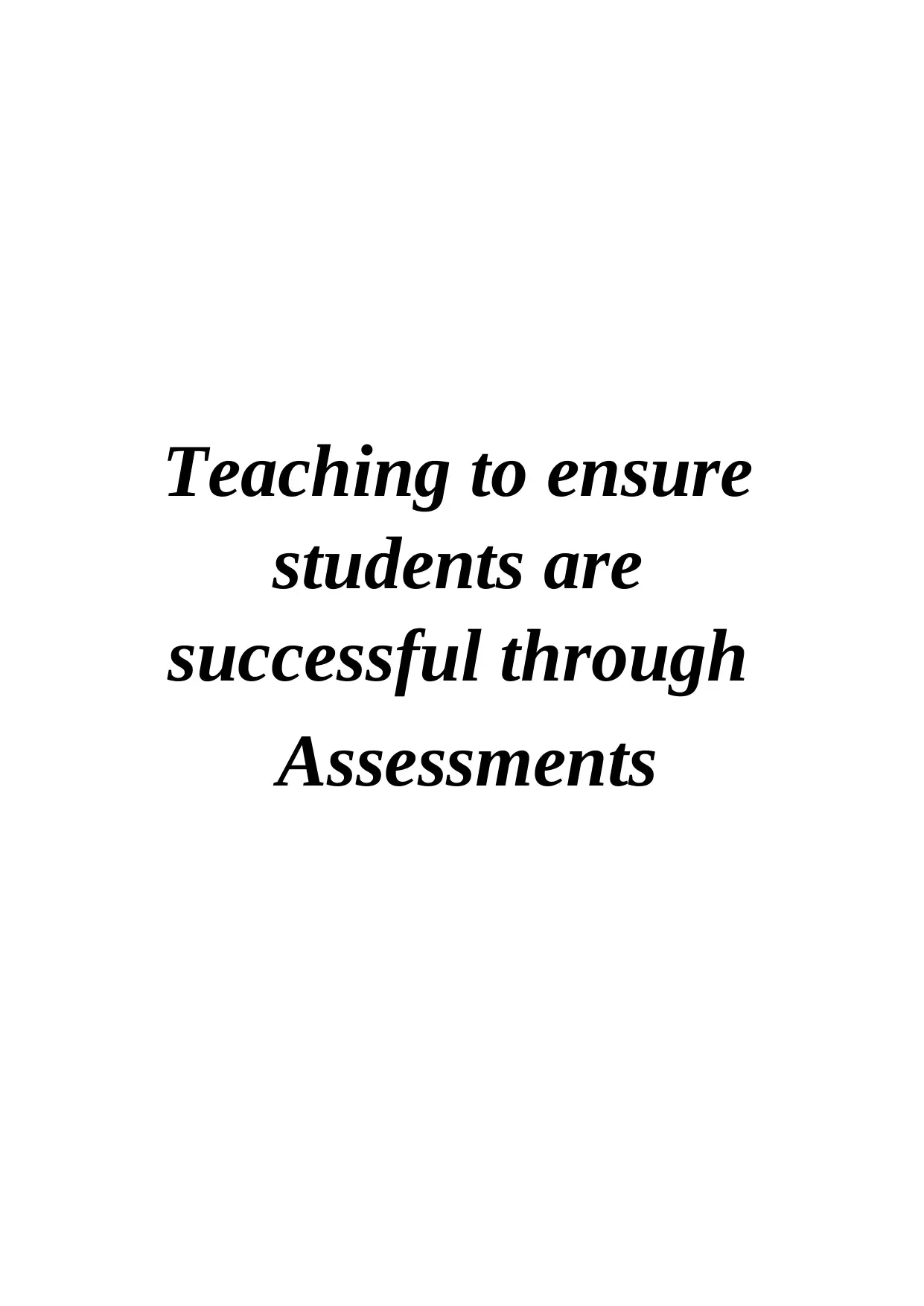
Teaching to ensure
students are
successful through
Assessments
students are
successful through
Assessments
Paraphrase This Document
Need a fresh take? Get an instant paraphrase of this document with our AI Paraphraser
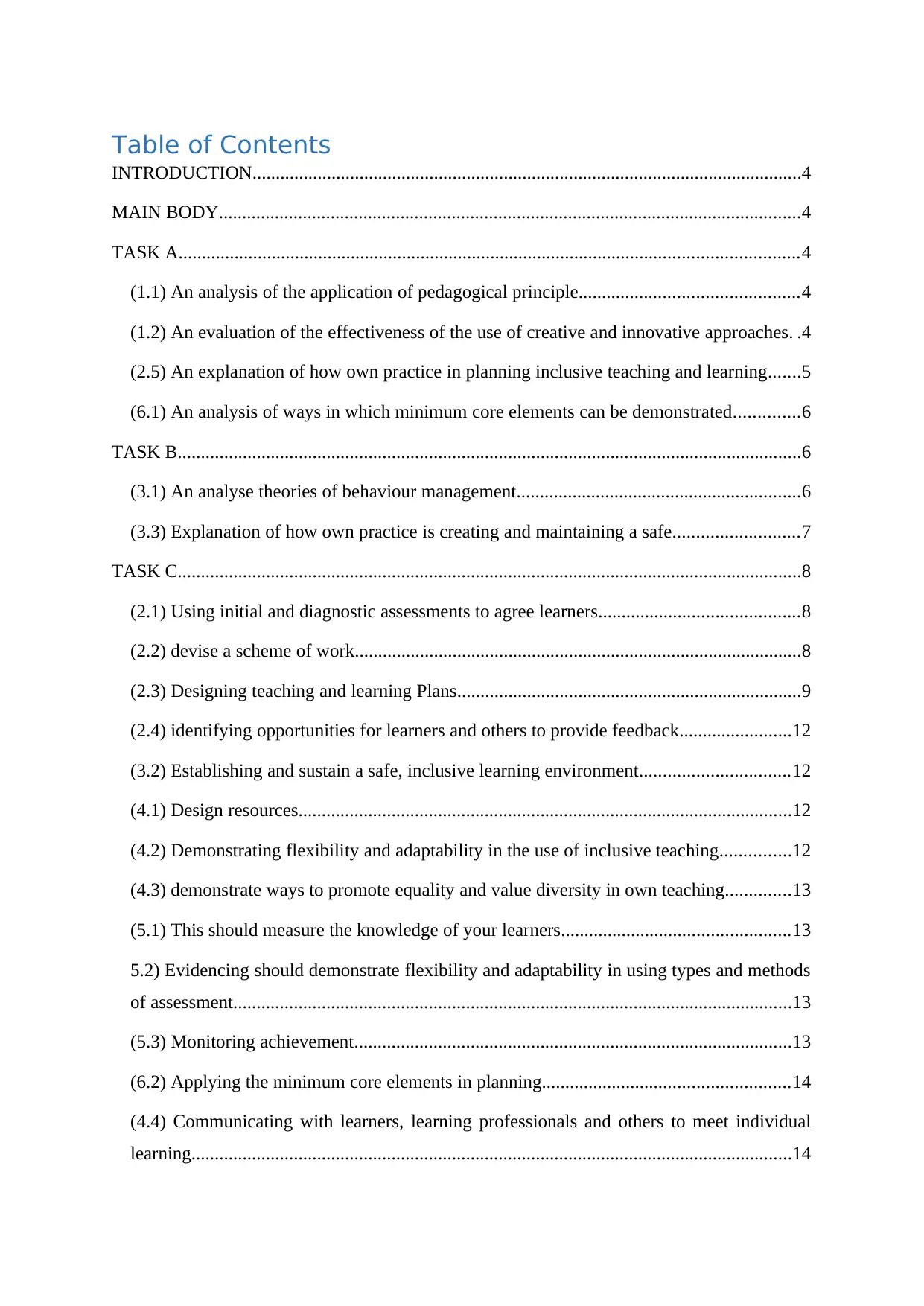
Table of Contents
INTRODUCTION......................................................................................................................4
MAIN BODY.............................................................................................................................4
TASK A.....................................................................................................................................4
(1.1) An analysis of the application of pedagogical principle...............................................4
(1.2) An evaluation of the effectiveness of the use of creative and innovative approaches. .4
(2.5) An explanation of how own practice in planning inclusive teaching and learning.......5
(6.1) An analysis of ways in which minimum core elements can be demonstrated..............6
TASK B......................................................................................................................................6
(3.1) An analyse theories of behaviour management.............................................................6
(3.3) Explanation of how own practice is creating and maintaining a safe...........................7
TASK C......................................................................................................................................8
(2.1) Using initial and diagnostic assessments to agree learners...........................................8
(2.2) devise a scheme of work................................................................................................8
(2.3) Designing teaching and learning Plans..........................................................................9
(2.4) identifying opportunities for learners and others to provide feedback........................12
(3.2) Establishing and sustain a safe, inclusive learning environment................................12
(4.1) Design resources..........................................................................................................12
(4.2) Demonstrating flexibility and adaptability in the use of inclusive teaching...............12
(4.3) demonstrate ways to promote equality and value diversity in own teaching..............13
(5.1) This should measure the knowledge of your learners.................................................13
5.2) Evidencing should demonstrate flexibility and adaptability in using types and methods
of assessment........................................................................................................................13
(5.3) Monitoring achievement..............................................................................................13
(6.2) Applying the minimum core elements in planning.....................................................14
(4.4) Communicating with learners, learning professionals and others to meet individual
learning.................................................................................................................................14
INTRODUCTION......................................................................................................................4
MAIN BODY.............................................................................................................................4
TASK A.....................................................................................................................................4
(1.1) An analysis of the application of pedagogical principle...............................................4
(1.2) An evaluation of the effectiveness of the use of creative and innovative approaches. .4
(2.5) An explanation of how own practice in planning inclusive teaching and learning.......5
(6.1) An analysis of ways in which minimum core elements can be demonstrated..............6
TASK B......................................................................................................................................6
(3.1) An analyse theories of behaviour management.............................................................6
(3.3) Explanation of how own practice is creating and maintaining a safe...........................7
TASK C......................................................................................................................................8
(2.1) Using initial and diagnostic assessments to agree learners...........................................8
(2.2) devise a scheme of work................................................................................................8
(2.3) Designing teaching and learning Plans..........................................................................9
(2.4) identifying opportunities for learners and others to provide feedback........................12
(3.2) Establishing and sustain a safe, inclusive learning environment................................12
(4.1) Design resources..........................................................................................................12
(4.2) Demonstrating flexibility and adaptability in the use of inclusive teaching...............12
(4.3) demonstrate ways to promote equality and value diversity in own teaching..............13
(5.1) This should measure the knowledge of your learners.................................................13
5.2) Evidencing should demonstrate flexibility and adaptability in using types and methods
of assessment........................................................................................................................13
(5.3) Monitoring achievement..............................................................................................13
(6.2) Applying the minimum core elements in planning.....................................................14
(4.4) Communicating with learners, learning professionals and others to meet individual
learning.................................................................................................................................14
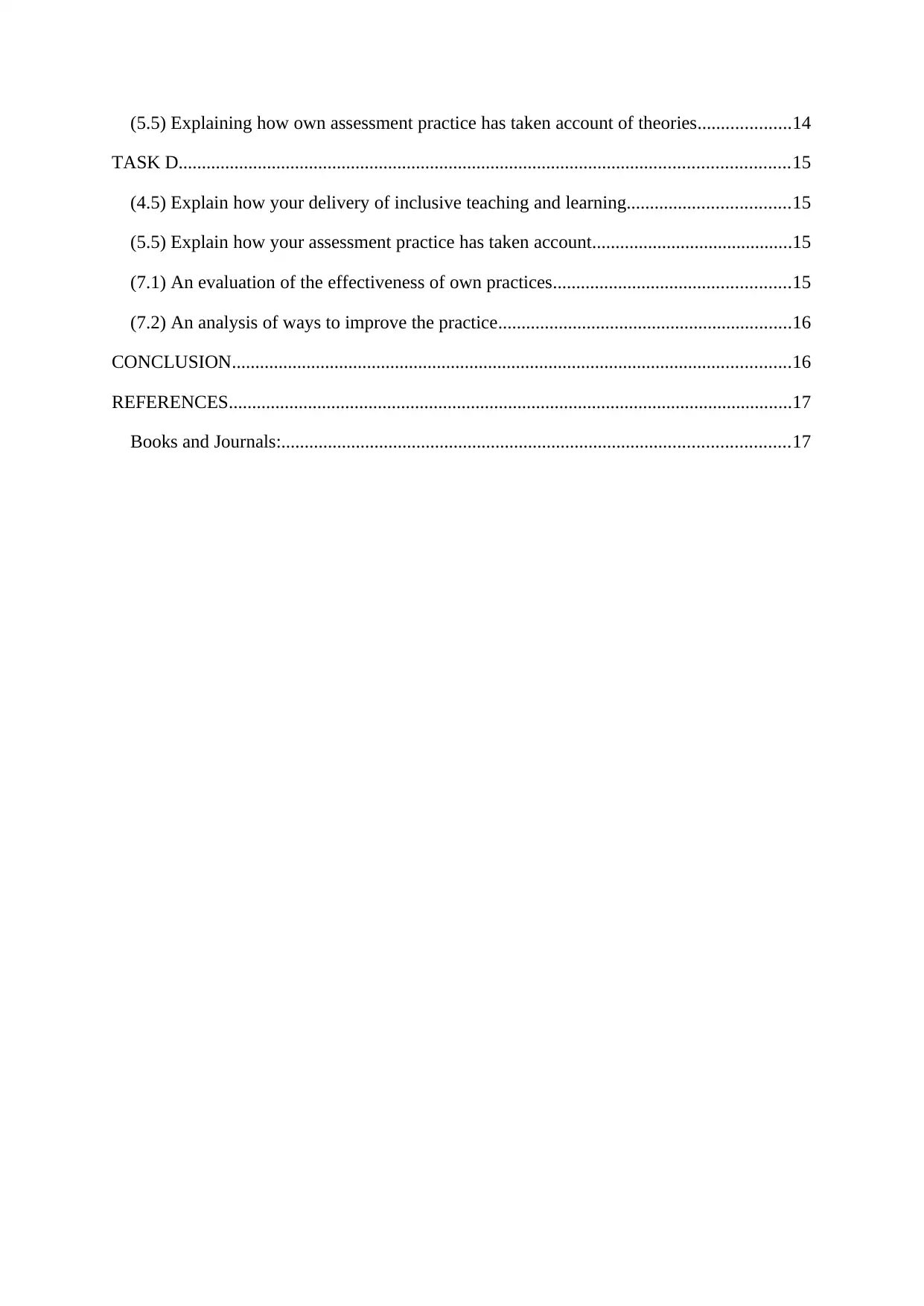
(5.5) Explaining how own assessment practice has taken account of theories....................14
TASK D...................................................................................................................................15
(4.5) Explain how your delivery of inclusive teaching and learning...................................15
(5.5) Explain how your assessment practice has taken account...........................................15
(7.1) An evaluation of the effectiveness of own practices...................................................15
(7.2) An analysis of ways to improve the practice...............................................................16
CONCLUSION........................................................................................................................16
REFERENCES.........................................................................................................................17
Books and Journals:.............................................................................................................17
TASK D...................................................................................................................................15
(4.5) Explain how your delivery of inclusive teaching and learning...................................15
(5.5) Explain how your assessment practice has taken account...........................................15
(7.1) An evaluation of the effectiveness of own practices...................................................15
(7.2) An analysis of ways to improve the practice...............................................................16
CONCLUSION........................................................................................................................16
REFERENCES.........................................................................................................................17
Books and Journals:.............................................................................................................17
⊘ This is a preview!⊘
Do you want full access?
Subscribe today to unlock all pages.

Trusted by 1+ million students worldwide
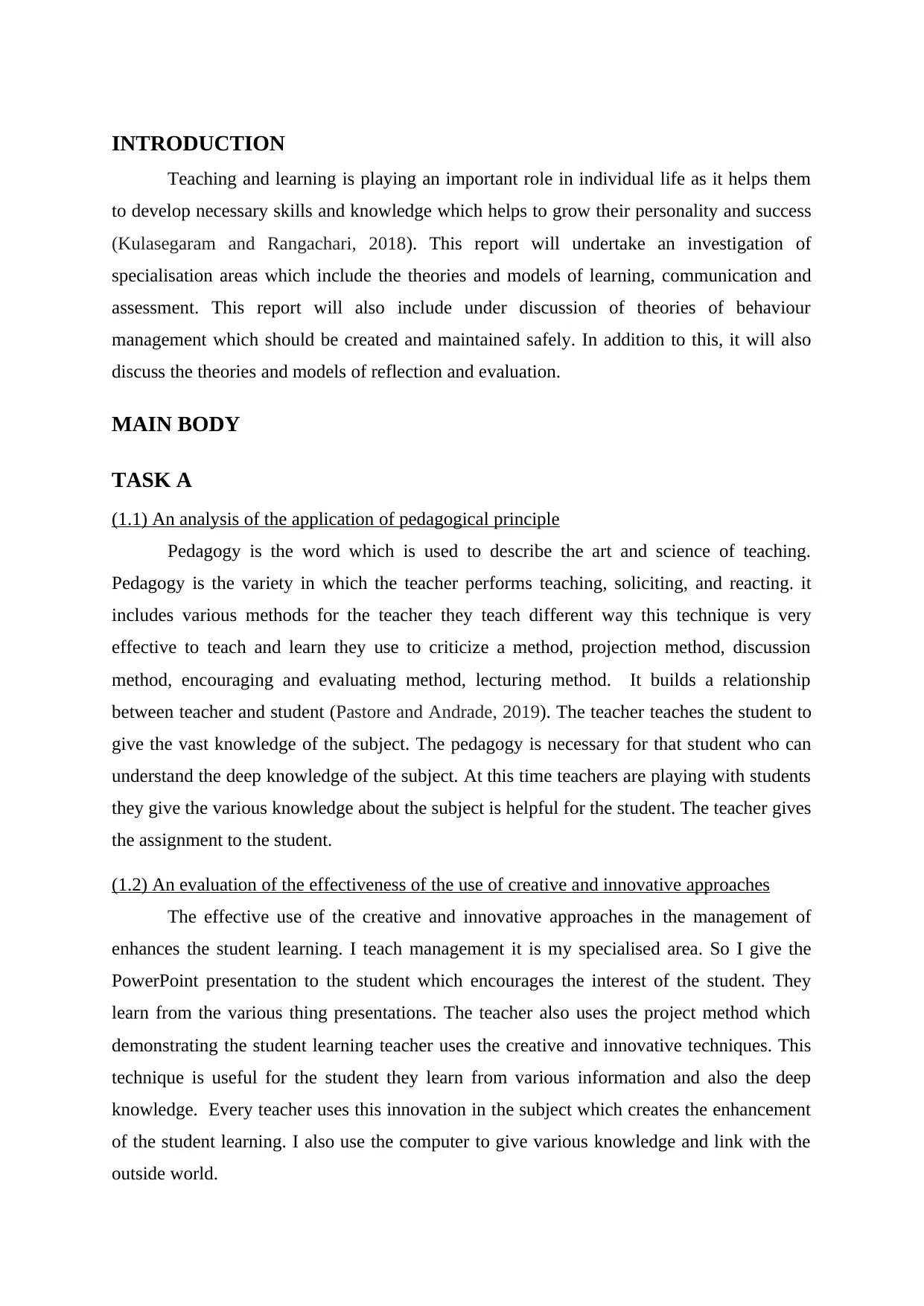
INTRODUCTION
Teaching and learning is playing an important role in individual life as it helps them
to develop necessary skills and knowledge which helps to grow their personality and success
(Kulasegaram and Rangachari, 2018). This report will undertake an investigation of
specialisation areas which include the theories and models of learning, communication and
assessment. This report will also include under discussion of theories of behaviour
management which should be created and maintained safely. In addition to this, it will also
discuss the theories and models of reflection and evaluation.
MAIN BODY
TASK A
(1.1) An analysis of the application of pedagogical principle
Pedagogy is the word which is used to describe the art and science of teaching.
Pedagogy is the variety in which the teacher performs teaching, soliciting, and reacting. it
includes various methods for the teacher they teach different way this technique is very
effective to teach and learn they use to criticize a method, projection method, discussion
method, encouraging and evaluating method, lecturing method. It builds a relationship
between teacher and student (Pastore and Andrade, 2019). The teacher teaches the student to
give the vast knowledge of the subject. The pedagogy is necessary for that student who can
understand the deep knowledge of the subject. At this time teachers are playing with students
they give the various knowledge about the subject is helpful for the student. The teacher gives
the assignment to the student.
(1.2) An evaluation of the effectiveness of the use of creative and innovative approaches
The effective use of the creative and innovative approaches in the management of
enhances the student learning. I teach management it is my specialised area. So I give the
PowerPoint presentation to the student which encourages the interest of the student. They
learn from the various thing presentations. The teacher also uses the project method which
demonstrating the student learning teacher uses the creative and innovative techniques. This
technique is useful for the student they learn from various information and also the deep
knowledge. Every teacher uses this innovation in the subject which creates the enhancement
of the student learning. I also use the computer to give various knowledge and link with the
outside world.
Teaching and learning is playing an important role in individual life as it helps them
to develop necessary skills and knowledge which helps to grow their personality and success
(Kulasegaram and Rangachari, 2018). This report will undertake an investigation of
specialisation areas which include the theories and models of learning, communication and
assessment. This report will also include under discussion of theories of behaviour
management which should be created and maintained safely. In addition to this, it will also
discuss the theories and models of reflection and evaluation.
MAIN BODY
TASK A
(1.1) An analysis of the application of pedagogical principle
Pedagogy is the word which is used to describe the art and science of teaching.
Pedagogy is the variety in which the teacher performs teaching, soliciting, and reacting. it
includes various methods for the teacher they teach different way this technique is very
effective to teach and learn they use to criticize a method, projection method, discussion
method, encouraging and evaluating method, lecturing method. It builds a relationship
between teacher and student (Pastore and Andrade, 2019). The teacher teaches the student to
give the vast knowledge of the subject. The pedagogy is necessary for that student who can
understand the deep knowledge of the subject. At this time teachers are playing with students
they give the various knowledge about the subject is helpful for the student. The teacher gives
the assignment to the student.
(1.2) An evaluation of the effectiveness of the use of creative and innovative approaches
The effective use of the creative and innovative approaches in the management of
enhances the student learning. I teach management it is my specialised area. So I give the
PowerPoint presentation to the student which encourages the interest of the student. They
learn from the various thing presentations. The teacher also uses the project method which
demonstrating the student learning teacher uses the creative and innovative techniques. This
technique is useful for the student they learn from various information and also the deep
knowledge. Every teacher uses this innovation in the subject which creates the enhancement
of the student learning. I also use the computer to give various knowledge and link with the
outside world.
Paraphrase This Document
Need a fresh take? Get an instant paraphrase of this document with our AI Paraphraser
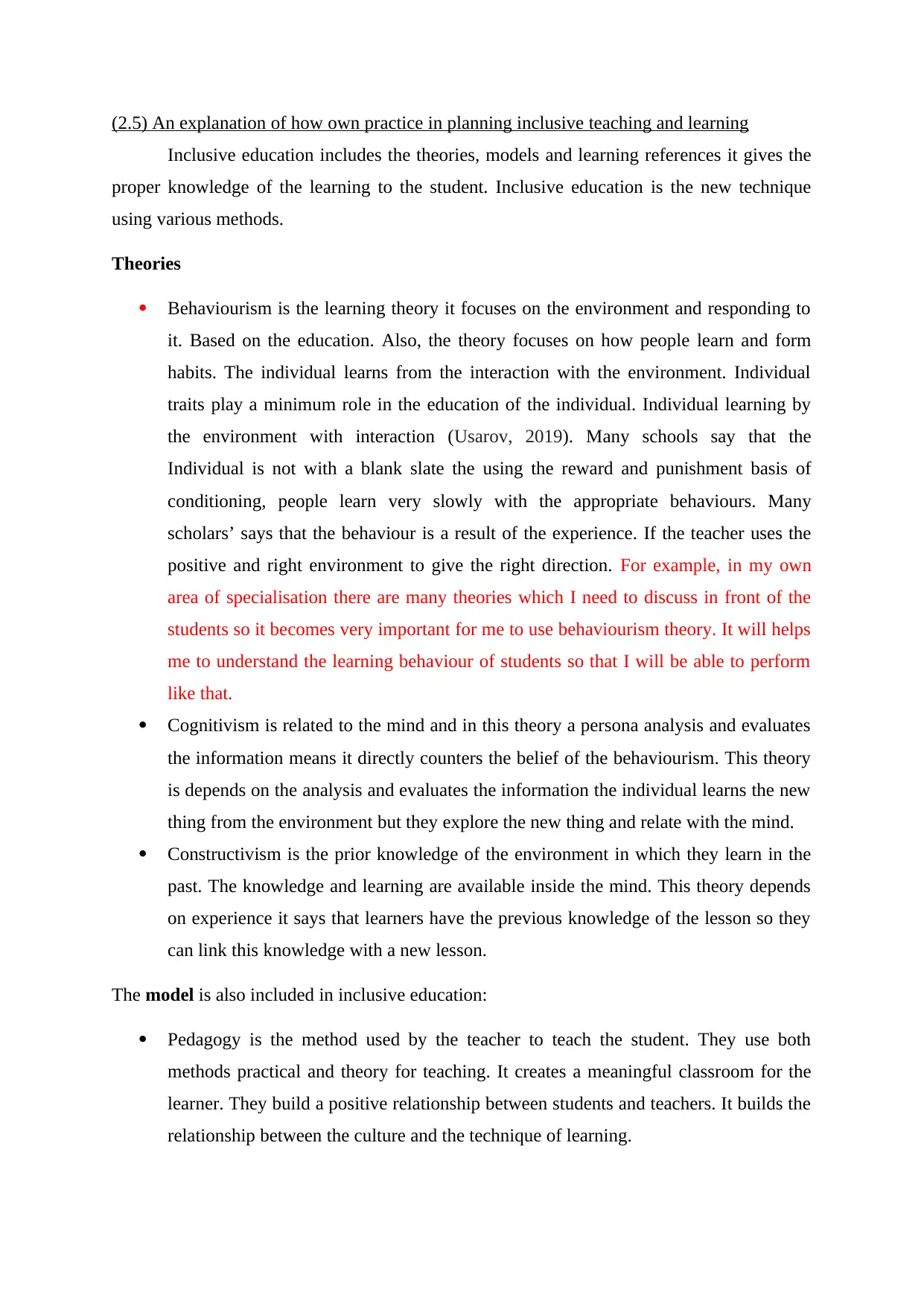
(2.5) An explanation of how own practice in planning inclusive teaching and learning
Inclusive education includes the theories, models and learning references it gives the
proper knowledge of the learning to the student. Inclusive education is the new technique
using various methods.
Theories
Behaviourism is the learning theory it focuses on the environment and responding to
it. Based on the education. Also, the theory focuses on how people learn and form
habits. The individual learns from the interaction with the environment. Individual
traits play a minimum role in the education of the individual. Individual learning by
the environment with interaction (Usarov, 2019). Many schools say that the
Individual is not with a blank slate the using the reward and punishment basis of
conditioning, people learn very slowly with the appropriate behaviours. Many
scholars’ says that the behaviour is a result of the experience. If the teacher uses the
positive and right environment to give the right direction. For example, in my own
area of specialisation there are many theories which I need to discuss in front of the
students so it becomes very important for me to use behaviourism theory. It will helps
me to understand the learning behaviour of students so that I will be able to perform
like that.
Cognitivism is related to the mind and in this theory a persona analysis and evaluates
the information means it directly counters the belief of the behaviourism. This theory
is depends on the analysis and evaluates the information the individual learns the new
thing from the environment but they explore the new thing and relate with the mind.
Constructivism is the prior knowledge of the environment in which they learn in the
past. The knowledge and learning are available inside the mind. This theory depends
on experience it says that learners have the previous knowledge of the lesson so they
can link this knowledge with a new lesson.
The model is also included in inclusive education:
Pedagogy is the method used by the teacher to teach the student. They use both
methods practical and theory for teaching. It creates a meaningful classroom for the
learner. They build a positive relationship between students and teachers. It builds the
relationship between the culture and the technique of learning.
Inclusive education includes the theories, models and learning references it gives the
proper knowledge of the learning to the student. Inclusive education is the new technique
using various methods.
Theories
Behaviourism is the learning theory it focuses on the environment and responding to
it. Based on the education. Also, the theory focuses on how people learn and form
habits. The individual learns from the interaction with the environment. Individual
traits play a minimum role in the education of the individual. Individual learning by
the environment with interaction (Usarov, 2019). Many schools say that the
Individual is not with a blank slate the using the reward and punishment basis of
conditioning, people learn very slowly with the appropriate behaviours. Many
scholars’ says that the behaviour is a result of the experience. If the teacher uses the
positive and right environment to give the right direction. For example, in my own
area of specialisation there are many theories which I need to discuss in front of the
students so it becomes very important for me to use behaviourism theory. It will helps
me to understand the learning behaviour of students so that I will be able to perform
like that.
Cognitivism is related to the mind and in this theory a persona analysis and evaluates
the information means it directly counters the belief of the behaviourism. This theory
is depends on the analysis and evaluates the information the individual learns the new
thing from the environment but they explore the new thing and relate with the mind.
Constructivism is the prior knowledge of the environment in which they learn in the
past. The knowledge and learning are available inside the mind. This theory depends
on experience it says that learners have the previous knowledge of the lesson so they
can link this knowledge with a new lesson.
The model is also included in inclusive education:
Pedagogy is the method used by the teacher to teach the student. They use both
methods practical and theory for teaching. It creates a meaningful classroom for the
learner. They build a positive relationship between students and teachers. It builds the
relationship between the culture and the technique of learning.
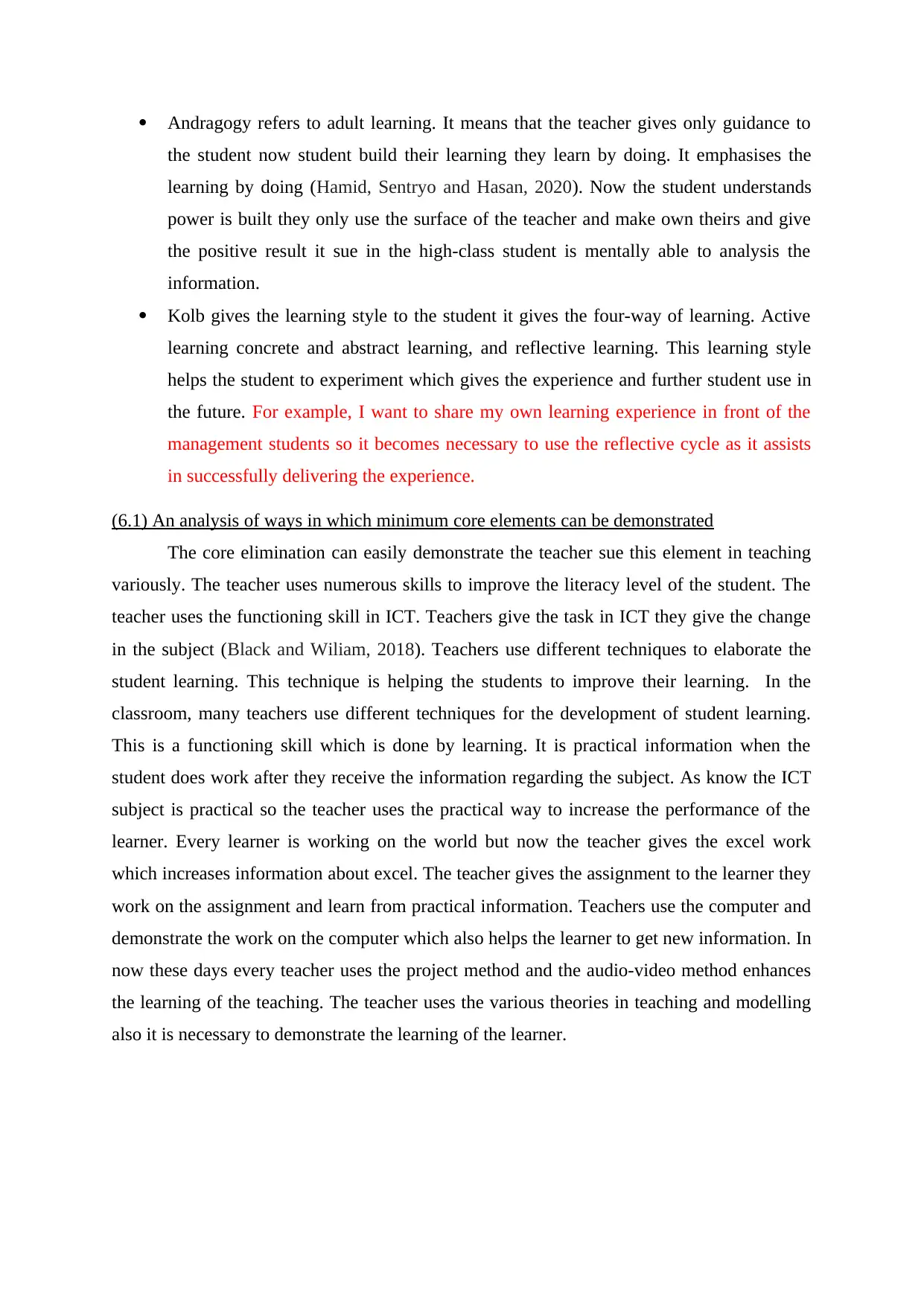
Andragogy refers to adult learning. It means that the teacher gives only guidance to
the student now student build their learning they learn by doing. It emphasises the
learning by doing (Hamid, Sentryo and Hasan, 2020). Now the student understands
power is built they only use the surface of the teacher and make own theirs and give
the positive result it sue in the high-class student is mentally able to analysis the
information.
Kolb gives the learning style to the student it gives the four-way of learning. Active
learning concrete and abstract learning, and reflective learning. This learning style
helps the student to experiment which gives the experience and further student use in
the future. For example, I want to share my own learning experience in front of the
management students so it becomes necessary to use the reflective cycle as it assists
in successfully delivering the experience.
(6.1) An analysis of ways in which minimum core elements can be demonstrated
The core elimination can easily demonstrate the teacher sue this element in teaching
variously. The teacher uses numerous skills to improve the literacy level of the student. The
teacher uses the functioning skill in ICT. Teachers give the task in ICT they give the change
in the subject (Black and Wiliam, 2018). Teachers use different techniques to elaborate the
student learning. This technique is helping the students to improve their learning. In the
classroom, many teachers use different techniques for the development of student learning.
This is a functioning skill which is done by learning. It is practical information when the
student does work after they receive the information regarding the subject. As know the ICT
subject is practical so the teacher uses the practical way to increase the performance of the
learner. Every learner is working on the world but now the teacher gives the excel work
which increases information about excel. The teacher gives the assignment to the learner they
work on the assignment and learn from practical information. Teachers use the computer and
demonstrate the work on the computer which also helps the learner to get new information. In
now these days every teacher uses the project method and the audio-video method enhances
the learning of the teaching. The teacher uses the various theories in teaching and modelling
also it is necessary to demonstrate the learning of the learner.
the student now student build their learning they learn by doing. It emphasises the
learning by doing (Hamid, Sentryo and Hasan, 2020). Now the student understands
power is built they only use the surface of the teacher and make own theirs and give
the positive result it sue in the high-class student is mentally able to analysis the
information.
Kolb gives the learning style to the student it gives the four-way of learning. Active
learning concrete and abstract learning, and reflective learning. This learning style
helps the student to experiment which gives the experience and further student use in
the future. For example, I want to share my own learning experience in front of the
management students so it becomes necessary to use the reflective cycle as it assists
in successfully delivering the experience.
(6.1) An analysis of ways in which minimum core elements can be demonstrated
The core elimination can easily demonstrate the teacher sue this element in teaching
variously. The teacher uses numerous skills to improve the literacy level of the student. The
teacher uses the functioning skill in ICT. Teachers give the task in ICT they give the change
in the subject (Black and Wiliam, 2018). Teachers use different techniques to elaborate the
student learning. This technique is helping the students to improve their learning. In the
classroom, many teachers use different techniques for the development of student learning.
This is a functioning skill which is done by learning. It is practical information when the
student does work after they receive the information regarding the subject. As know the ICT
subject is practical so the teacher uses the practical way to increase the performance of the
learner. Every learner is working on the world but now the teacher gives the excel work
which increases information about excel. The teacher gives the assignment to the learner they
work on the assignment and learn from practical information. Teachers use the computer and
demonstrate the work on the computer which also helps the learner to get new information. In
now these days every teacher uses the project method and the audio-video method enhances
the learning of the teaching. The teacher uses the various theories in teaching and modelling
also it is necessary to demonstrate the learning of the learner.
⊘ This is a preview!⊘
Do you want full access?
Subscribe today to unlock all pages.

Trusted by 1+ million students worldwide
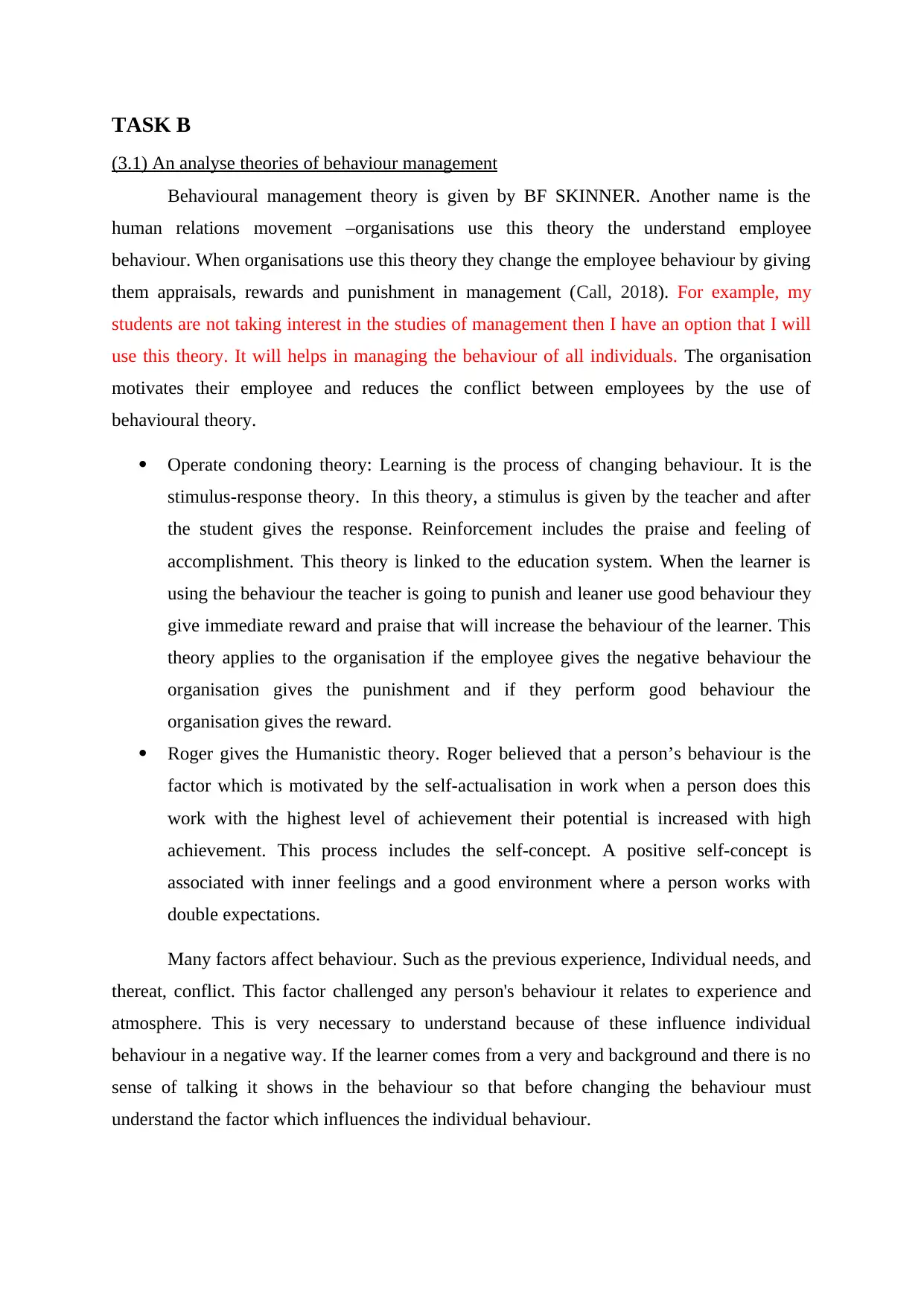
TASK B
(3.1) An analyse theories of behaviour management
Behavioural management theory is given by BF SKINNER. Another name is the
human relations movement –organisations use this theory the understand employee
behaviour. When organisations use this theory they change the employee behaviour by giving
them appraisals, rewards and punishment in management (Call, 2018). For example, my
students are not taking interest in the studies of management then I have an option that I will
use this theory. It will helps in managing the behaviour of all individuals. The organisation
motivates their employee and reduces the conflict between employees by the use of
behavioural theory.
Operate condoning theory: Learning is the process of changing behaviour. It is the
stimulus-response theory. In this theory, a stimulus is given by the teacher and after
the student gives the response. Reinforcement includes the praise and feeling of
accomplishment. This theory is linked to the education system. When the learner is
using the behaviour the teacher is going to punish and leaner use good behaviour they
give immediate reward and praise that will increase the behaviour of the learner. This
theory applies to the organisation if the employee gives the negative behaviour the
organisation gives the punishment and if they perform good behaviour the
organisation gives the reward.
Roger gives the Humanistic theory. Roger believed that a person’s behaviour is the
factor which is motivated by the self-actualisation in work when a person does this
work with the highest level of achievement their potential is increased with high
achievement. This process includes the self-concept. A positive self-concept is
associated with inner feelings and a good environment where a person works with
double expectations.
Many factors affect behaviour. Such as the previous experience, Individual needs, and
thereat, conflict. This factor challenged any person's behaviour it relates to experience and
atmosphere. This is very necessary to understand because of these influence individual
behaviour in a negative way. If the learner comes from a very and background and there is no
sense of talking it shows in the behaviour so that before changing the behaviour must
understand the factor which influences the individual behaviour.
(3.1) An analyse theories of behaviour management
Behavioural management theory is given by BF SKINNER. Another name is the
human relations movement –organisations use this theory the understand employee
behaviour. When organisations use this theory they change the employee behaviour by giving
them appraisals, rewards and punishment in management (Call, 2018). For example, my
students are not taking interest in the studies of management then I have an option that I will
use this theory. It will helps in managing the behaviour of all individuals. The organisation
motivates their employee and reduces the conflict between employees by the use of
behavioural theory.
Operate condoning theory: Learning is the process of changing behaviour. It is the
stimulus-response theory. In this theory, a stimulus is given by the teacher and after
the student gives the response. Reinforcement includes the praise and feeling of
accomplishment. This theory is linked to the education system. When the learner is
using the behaviour the teacher is going to punish and leaner use good behaviour they
give immediate reward and praise that will increase the behaviour of the learner. This
theory applies to the organisation if the employee gives the negative behaviour the
organisation gives the punishment and if they perform good behaviour the
organisation gives the reward.
Roger gives the Humanistic theory. Roger believed that a person’s behaviour is the
factor which is motivated by the self-actualisation in work when a person does this
work with the highest level of achievement their potential is increased with high
achievement. This process includes the self-concept. A positive self-concept is
associated with inner feelings and a good environment where a person works with
double expectations.
Many factors affect behaviour. Such as the previous experience, Individual needs, and
thereat, conflict. This factor challenged any person's behaviour it relates to experience and
atmosphere. This is very necessary to understand because of these influence individual
behaviour in a negative way. If the learner comes from a very and background and there is no
sense of talking it shows in the behaviour so that before changing the behaviour must
understand the factor which influences the individual behaviour.
Paraphrase This Document
Need a fresh take? Get an instant paraphrase of this document with our AI Paraphraser
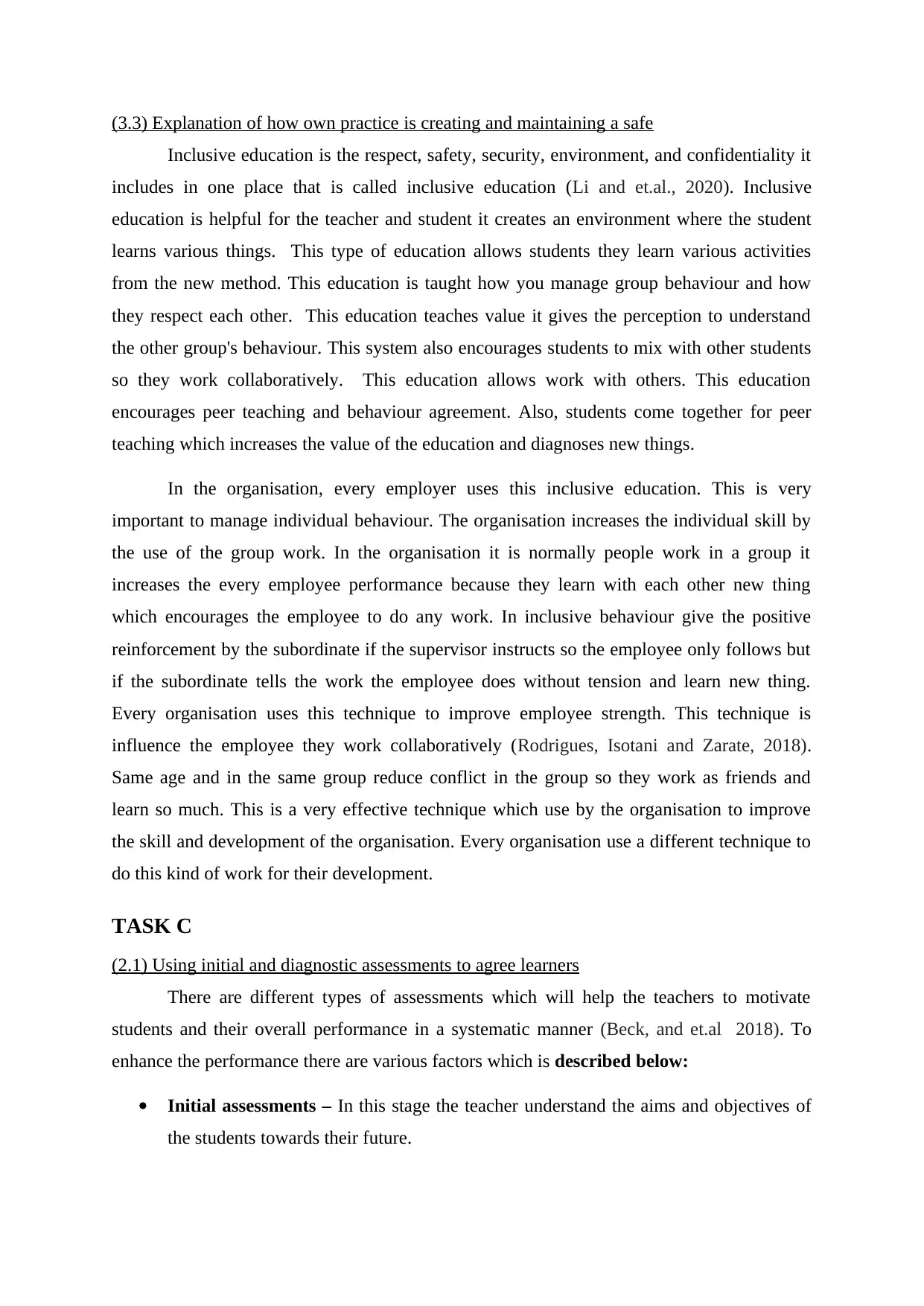
(3.3) Explanation of how own practice is creating and maintaining a safe
Inclusive education is the respect, safety, security, environment, and confidentiality it
includes in one place that is called inclusive education (Li and et.al., 2020). Inclusive
education is helpful for the teacher and student it creates an environment where the student
learns various things. This type of education allows students they learn various activities
from the new method. This education is taught how you manage group behaviour and how
they respect each other. This education teaches value it gives the perception to understand
the other group's behaviour. This system also encourages students to mix with other students
so they work collaboratively. This education allows work with others. This education
encourages peer teaching and behaviour agreement. Also, students come together for peer
teaching which increases the value of the education and diagnoses new things.
In the organisation, every employer uses this inclusive education. This is very
important to manage individual behaviour. The organisation increases the individual skill by
the use of the group work. In the organisation it is normally people work in a group it
increases the every employee performance because they learn with each other new thing
which encourages the employee to do any work. In inclusive behaviour give the positive
reinforcement by the subordinate if the supervisor instructs so the employee only follows but
if the subordinate tells the work the employee does without tension and learn new thing.
Every organisation uses this technique to improve employee strength. This technique is
influence the employee they work collaboratively (Rodrigues, Isotani and Zarate, 2018).
Same age and in the same group reduce conflict in the group so they work as friends and
learn so much. This is a very effective technique which use by the organisation to improve
the skill and development of the organisation. Every organisation use a different technique to
do this kind of work for their development.
TASK C
(2.1) Using initial and diagnostic assessments to agree learners
There are different types of assessments which will help the teachers to motivate
students and their overall performance in a systematic manner (Beck, and et.al 2018). To
enhance the performance there are various factors which is described below:
Initial assessments – In this stage the teacher understand the aims and objectives of
the students towards their future.
Inclusive education is the respect, safety, security, environment, and confidentiality it
includes in one place that is called inclusive education (Li and et.al., 2020). Inclusive
education is helpful for the teacher and student it creates an environment where the student
learns various things. This type of education allows students they learn various activities
from the new method. This education is taught how you manage group behaviour and how
they respect each other. This education teaches value it gives the perception to understand
the other group's behaviour. This system also encourages students to mix with other students
so they work collaboratively. This education allows work with others. This education
encourages peer teaching and behaviour agreement. Also, students come together for peer
teaching which increases the value of the education and diagnoses new things.
In the organisation, every employer uses this inclusive education. This is very
important to manage individual behaviour. The organisation increases the individual skill by
the use of the group work. In the organisation it is normally people work in a group it
increases the every employee performance because they learn with each other new thing
which encourages the employee to do any work. In inclusive behaviour give the positive
reinforcement by the subordinate if the supervisor instructs so the employee only follows but
if the subordinate tells the work the employee does without tension and learn new thing.
Every organisation uses this technique to improve employee strength. This technique is
influence the employee they work collaboratively (Rodrigues, Isotani and Zarate, 2018).
Same age and in the same group reduce conflict in the group so they work as friends and
learn so much. This is a very effective technique which use by the organisation to improve
the skill and development of the organisation. Every organisation use a different technique to
do this kind of work for their development.
TASK C
(2.1) Using initial and diagnostic assessments to agree learners
There are different types of assessments which will help the teachers to motivate
students and their overall performance in a systematic manner (Beck, and et.al 2018). To
enhance the performance there are various factors which is described below:
Initial assessments – In this stage the teacher understand the aims and objectives of
the students towards their future.
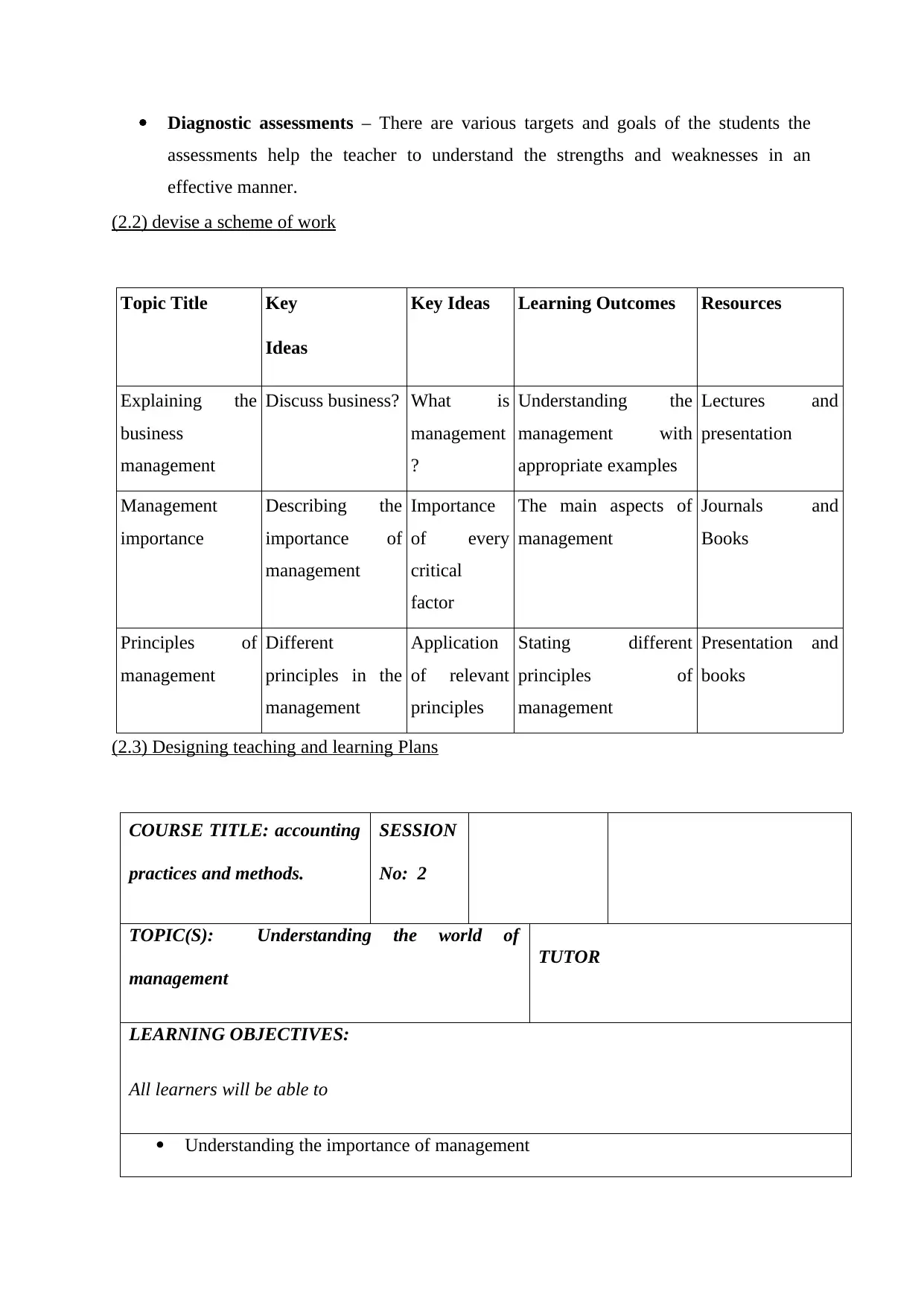
Diagnostic assessments – There are various targets and goals of the students the
assessments help the teacher to understand the strengths and weaknesses in an
effective manner.
(2.2) devise a scheme of work
Topic Title Key
Ideas
Key Ideas Learning Outcomes Resources
Explaining the
business
management
Discuss business? What is
management
?
Understanding the
management with
appropriate examples
Lectures and
presentation
Management
importance
Describing the
importance of
management
Importance
of every
critical
factor
The main aspects of
management
Journals and
Books
Principles of
management
Different
principles in the
management
Application
of relevant
principles
Stating different
principles of
management
Presentation and
books
(2.3) Designing teaching and learning Plans
COURSE TITLE: accounting
practices and methods.
SESSION
No: 2
TOPIC(S): Understanding the world of
management
TUTOR
LEARNING OBJECTIVES:
All learners will be able to
Understanding the importance of management
assessments help the teacher to understand the strengths and weaknesses in an
effective manner.
(2.2) devise a scheme of work
Topic Title Key
Ideas
Key Ideas Learning Outcomes Resources
Explaining the
business
management
Discuss business? What is
management
?
Understanding the
management with
appropriate examples
Lectures and
presentation
Management
importance
Describing the
importance of
management
Importance
of every
critical
factor
The main aspects of
management
Journals and
Books
Principles of
management
Different
principles in the
management
Application
of relevant
principles
Stating different
principles of
management
Presentation and
books
(2.3) Designing teaching and learning Plans
COURSE TITLE: accounting
practices and methods.
SESSION
No: 2
TOPIC(S): Understanding the world of
management
TUTOR
LEARNING OBJECTIVES:
All learners will be able to
Understanding the importance of management
⊘ This is a preview!⊘
Do you want full access?
Subscribe today to unlock all pages.

Trusted by 1+ million students worldwide
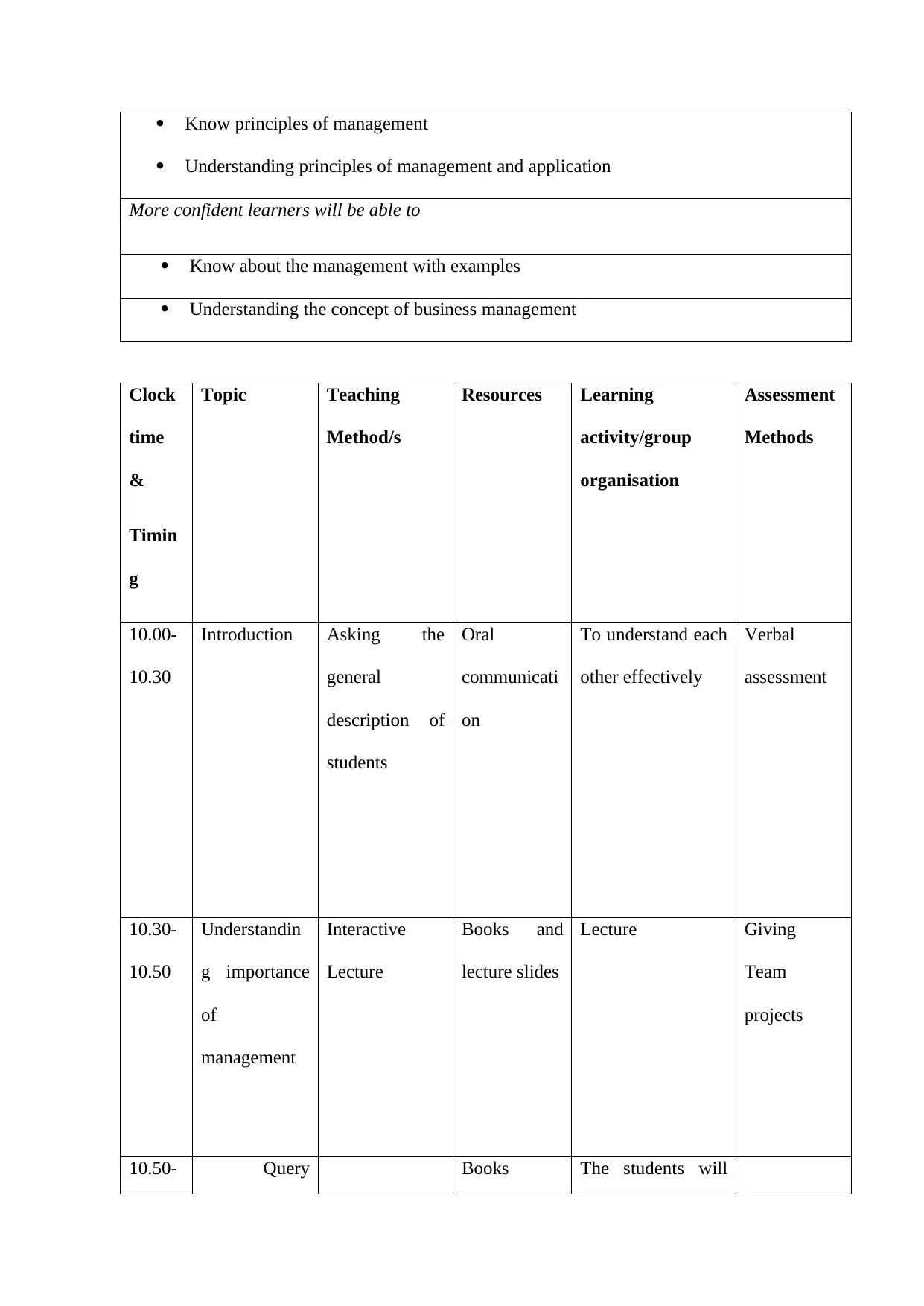
Know principles of management
Understanding principles of management and application
More confident learners will be able to
Know about the management with examples
Understanding the concept of business management
Clock
time
&
Timin
g
Topic Teaching
Method/s
Resources Learning
activity/group
organisation
Assessment
Methods
10.00-
10.30
Introduction Asking the
general
description of
students
Oral
communicati
on
To understand each
other effectively
Verbal
assessment
10.30-
10.50
Understandin
g importance
of
management
Interactive
Lecture
Books and
lecture slides
Lecture Giving
Team
projects
10.50- Query Books The students will
Understanding principles of management and application
More confident learners will be able to
Know about the management with examples
Understanding the concept of business management
Clock
time
&
Timin
g
Topic Teaching
Method/s
Resources Learning
activity/group
organisation
Assessment
Methods
10.00-
10.30
Introduction Asking the
general
description of
students
Oral
communicati
on
To understand each
other effectively
Verbal
assessment
10.30-
10.50
Understandin
g importance
of
management
Interactive
Lecture
Books and
lecture slides
Lecture Giving
Team
projects
10.50- Query Books The students will
Paraphrase This Document
Need a fresh take? Get an instant paraphrase of this document with our AI Paraphraser
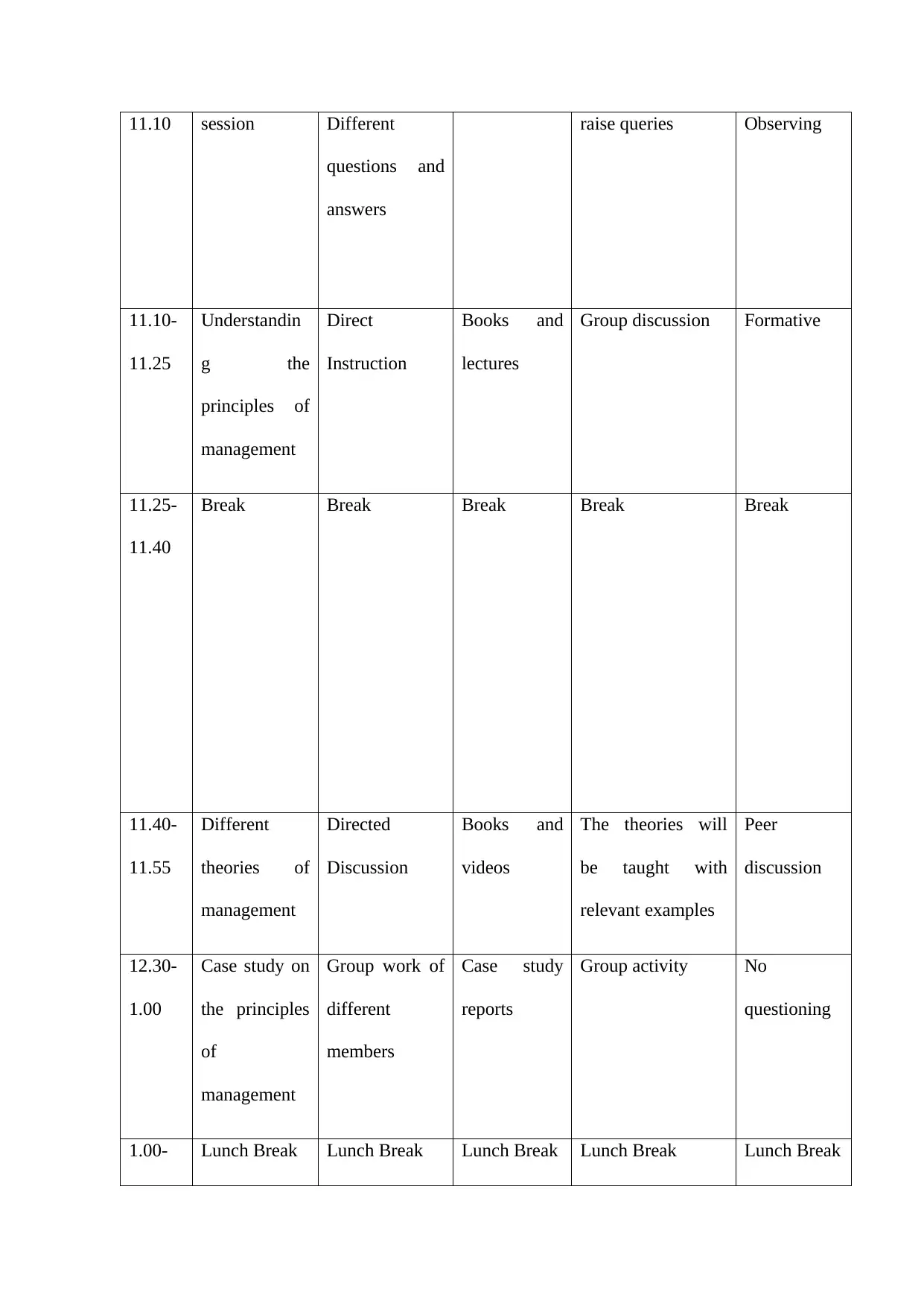
11.10 session Different
questions and
answers
raise queries Observing
11.10-
11.25
Understandin
g the
principles of
management
Direct
Instruction
Books and
lectures
Group discussion Formative
11.25-
11.40
Break Break Break Break Break
11.40-
11.55
Different
theories of
management
Directed
Discussion
Books and
videos
The theories will
be taught with
relevant examples
Peer
discussion
12.30-
1.00
Case study on
the principles
of
management
Group work of
different
members
Case study
reports
Group activity No
questioning
1.00- Lunch Break Lunch Break Lunch Break Lunch Break Lunch Break
questions and
answers
raise queries Observing
11.10-
11.25
Understandin
g the
principles of
management
Direct
Instruction
Books and
lectures
Group discussion Formative
11.25-
11.40
Break Break Break Break Break
11.40-
11.55
Different
theories of
management
Directed
Discussion
Books and
videos
The theories will
be taught with
relevant examples
Peer
discussion
12.30-
1.00
Case study on
the principles
of
management
Group work of
different
members
Case study
reports
Group activity No
questioning
1.00- Lunch Break Lunch Break Lunch Break Lunch Break Lunch Break
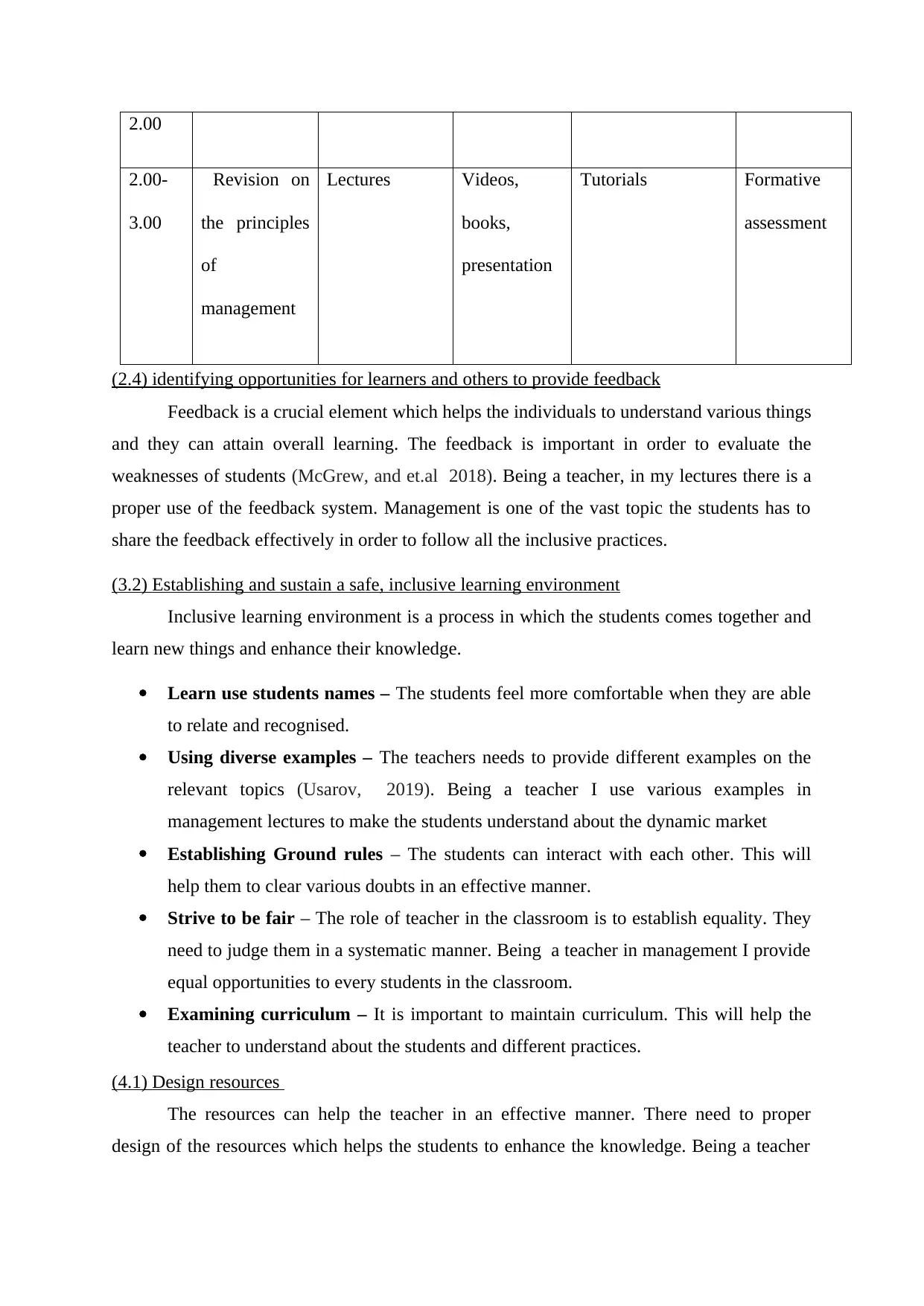
2.00
2.00-
3.00
Revision on
the principles
of
management
Lectures Videos,
books,
presentation
Tutorials Formative
assessment
(2.4) identifying opportunities for learners and others to provide feedback
Feedback is a crucial element which helps the individuals to understand various things
and they can attain overall learning. The feedback is important in order to evaluate the
weaknesses of students (McGrew, and et.al 2018). Being a teacher, in my lectures there is a
proper use of the feedback system. Management is one of the vast topic the students has to
share the feedback effectively in order to follow all the inclusive practices.
(3.2) Establishing and sustain a safe, inclusive learning environment
Inclusive learning environment is a process in which the students comes together and
learn new things and enhance their knowledge.
Learn use students names – The students feel more comfortable when they are able
to relate and recognised.
Using diverse examples – The teachers needs to provide different examples on the
relevant topics (Usarov, 2019). Being a teacher I use various examples in
management lectures to make the students understand about the dynamic market
Establishing Ground rules – The students can interact with each other. This will
help them to clear various doubts in an effective manner.
Strive to be fair – The role of teacher in the classroom is to establish equality. They
need to judge them in a systematic manner. Being a teacher in management I provide
equal opportunities to every students in the classroom.
Examining curriculum – It is important to maintain curriculum. This will help the
teacher to understand about the students and different practices.
(4.1) Design resources
The resources can help the teacher in an effective manner. There need to proper
design of the resources which helps the students to enhance the knowledge. Being a teacher
2.00-
3.00
Revision on
the principles
of
management
Lectures Videos,
books,
presentation
Tutorials Formative
assessment
(2.4) identifying opportunities for learners and others to provide feedback
Feedback is a crucial element which helps the individuals to understand various things
and they can attain overall learning. The feedback is important in order to evaluate the
weaknesses of students (McGrew, and et.al 2018). Being a teacher, in my lectures there is a
proper use of the feedback system. Management is one of the vast topic the students has to
share the feedback effectively in order to follow all the inclusive practices.
(3.2) Establishing and sustain a safe, inclusive learning environment
Inclusive learning environment is a process in which the students comes together and
learn new things and enhance their knowledge.
Learn use students names – The students feel more comfortable when they are able
to relate and recognised.
Using diverse examples – The teachers needs to provide different examples on the
relevant topics (Usarov, 2019). Being a teacher I use various examples in
management lectures to make the students understand about the dynamic market
Establishing Ground rules – The students can interact with each other. This will
help them to clear various doubts in an effective manner.
Strive to be fair – The role of teacher in the classroom is to establish equality. They
need to judge them in a systematic manner. Being a teacher in management I provide
equal opportunities to every students in the classroom.
Examining curriculum – It is important to maintain curriculum. This will help the
teacher to understand about the students and different practices.
(4.1) Design resources
The resources can help the teacher in an effective manner. There need to proper
design of the resources which helps the students to enhance the knowledge. Being a teacher
⊘ This is a preview!⊘
Do you want full access?
Subscribe today to unlock all pages.

Trusted by 1+ million students worldwide
1 out of 18
Related Documents
Your All-in-One AI-Powered Toolkit for Academic Success.
+13062052269
info@desklib.com
Available 24*7 on WhatsApp / Email
![[object Object]](/_next/static/media/star-bottom.7253800d.svg)
Unlock your academic potential
Copyright © 2020–2025 A2Z Services. All Rights Reserved. Developed and managed by ZUCOL.





